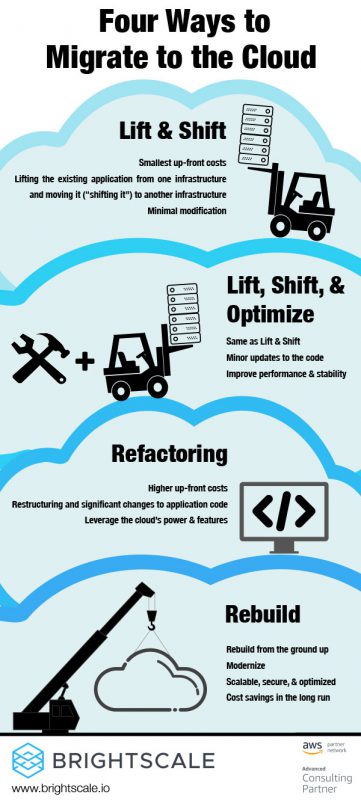Over the last several years, we have seen a mass exodus from on-premise and colo infrastructure to the cloud. There are several reasons organizations are moving to the cloud, but one of the main reasons is a reduction costs to maintain their applications. It is true that applications migrated to the cloud reduce costs in the long run. However, if the migration was not thought out well or done incorrectly, the organization can be leaving money on the table when it comes to cost savings (and other positive outcomes).
The first thing an organization needs to do is determine the best migration for their applications. Most migrations fall within 4 categories.
The Lift and Shift –
Lift and Shift requires the least up-front costs. In a nutshell, it is lifting the existing application from one infrastructure and moving it (“shifting it”) to another infrastructure. With this method there is effectively zero modification to the code. This method usually takes the least amount of time, but it may not always save the organization money because the application may not be optimized for the cloud. The organization is likely minimally leveraging the power of the AWS cloud at the end of this step.
The Lift, Shift, and Optimize –
Lift, Shift, and Optimize is very similar to Lift and Shift with the addition of making some code changes and updates to the app improve performance and stability. Organizations may go this route if they know their application needs minor updates to be compatible with AWS cloud, but do not want to go the route of a full rebuild. Although this usually reduces costs in the long run, the cost savings are still limited because it cannot fully leverage all of AWS’ cloud features.
Refactoring –
An organization may want to move their application to the cloud but is incompatible. In this case, refactoring is an option. Refactoring is restructuring or making major changes to the application’s code. When an organization refactors their application for AWS cloud, they can leverage AWS cloud’s power and features. In the long run, the organization will experience great cost savings over time, but there will be increased upfront costs to achieve the refactoring.
Rebuild –
The final option is not really a migration. It is rebuilding the application from the ground up in AWS cloud. This is potentially a very good choice to couple with a modernization effort. The additional benefit of a rebuild is taking advantage of all that AWS cloud has to offer. It means the organization can map out the cloud infrastructure and build the application to be scalable, secure, and optimized for performance and cost savings. This, like refactoring, can be a large undertaking, but the organization will reap significant cost savings in the long run.
The second thing an organization needs to do is decide who will do the migration. Will it be done in-house with available resources or an AWS consulting partner. There are pros and cons to both.
Using in-house resources in your IT department may save costs in the migration, but there are other factors an organization should evaluate such as time required of the resources. They should look at the resource’s knowledge and experience with cloud environments as the cloud is very different from on-premise infrastructures. In-house resources are probably equipped for Lift and Shift and Lift, Shift, and Optimize, but may be too inexperienced for Refactoring or Rebuilding.
If the organization wants to Refactor or Rebuild their applications in the cloud, an AWS Consulting Partner would be a better choice. The cost to hire a consultant may be higher up front, but with assurance the cloud infrastructure and app will be built correctly, the organization will drastically reduce costs in the long run. They can also teach your internal resources what they need to know so as to support the applications in the long run.
The best way to migrate is not always an easy decision, but you want to make the right decision that reduce costs in the long run. As an AWS Consulting Partner, we would be happy to discuss your options and help you decide the best method to migrate your application. Feel free to contact us.


